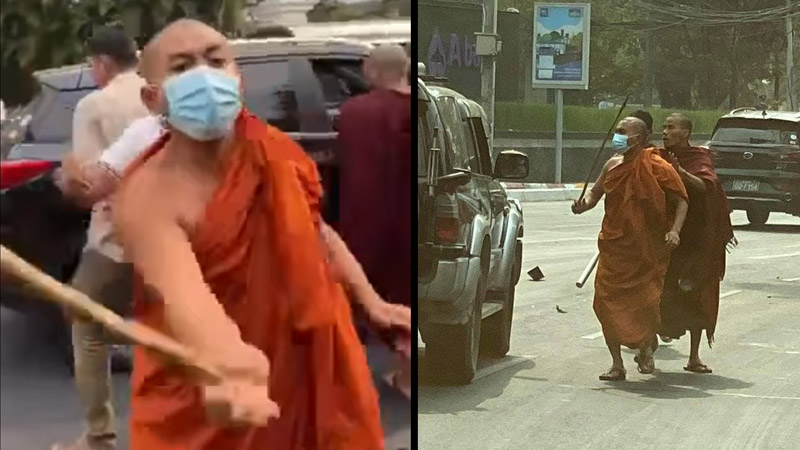A group of people wearing robes yesterday smashed the windows of cars waiting at a traffic light on Yangon’s Bahan 3 Road.
What appeared to be four monks and five civilians used iron bars to bash the windows of four vehicles and injured at least one occupant at the traffic stop, according to witnesses and victims.
“Four monks and five plainclothes men ran down the road, smashed the car in front of me and smashed the rear window of my car behind him,” one female victim identified as Ei Thu told reporters.
Singapore brands face Myanmar boycott for ‘supporting the dictatorship’
The woman said the attackers only seemed to target cars and people with signs or stickers rejecting the recent coup d’etat. Indeed, the damaged vehicles all appeared in images from the scene to carry signs opposing military rule or supporting civilian leader Aung San Suu Kyi.
“When we were waiting for the traffic light, about seven people in civilian clothes came out of the monastery next door and hit the two cars in front first. Then they came to us and smashed the front mirror. My father shouted for help as they opened the car door and beat him,” Su May Win wrote on social media.
There was wide speculation the monks were ultranationalist hardliners recruited by the military to stir up trouble.
“So rude. They also hit my dad and hit the cars,” she added. “No idea if they are real or fake monks.”
A car with an Aung San Suu Kyi poster was attacked.
The attacks come amid accusations the military has been fielding bands of thugs to harass people, particularly at night.
For the past two days, motorists in Yangon have paralyzed traffic on some roads by stopping their vehicles on the city’s main roads and claiming mechanical failure when the police come by.
Owners of the damaged vehicles said they would take their recorded evidence to the police, who were later seen investigating the crime scene.
It was the first time since the Feb. 1 coup that civilians not soldiers were recorded carrying out acts of violence in Yangon.
Others said it reminded them of tactics used during the 1988 uprising, when the military deployed fake monks and agitators to stir up conflict.
On Wednesday, hundreds of thousands of people gathered at a mass rally near Yangon’s Sule Pagoda, where 88 Generation Student Leader U Min Ko Naing delivered a recorded message imploring people to continue the fight. Civilian lawmakers, students union leaders and more called for democracy and refused to go back to “the dark ages.” The pervasive civil disobedience movement was said to have the support of 14,000 government workers in 268 townships nationwide.
“We are not giving up this time. We must defeat them,” said Hnin, a 25-year-old sales executive who addressed the crowd. “Let’s end this dictatorship. Once and for all.”
A day earlier, in Naypyidaw, the military held its own news conference where it implausibly insisted that 40 million of Myanmar’s roughly 54 million people supported it, making its crushing defeat in November’s election an unacceptable impossibility.
About a dozen reporters for the English-language Myanmar Times resigned yesterday after the military junta issued a series of media edicts, including an order they should not be referred to as a “military junta.”




